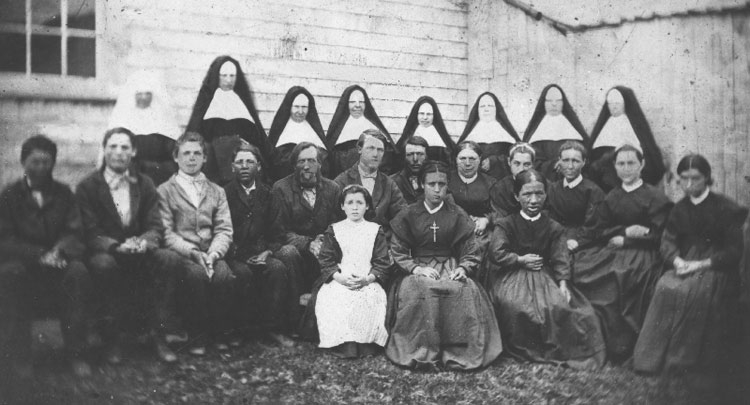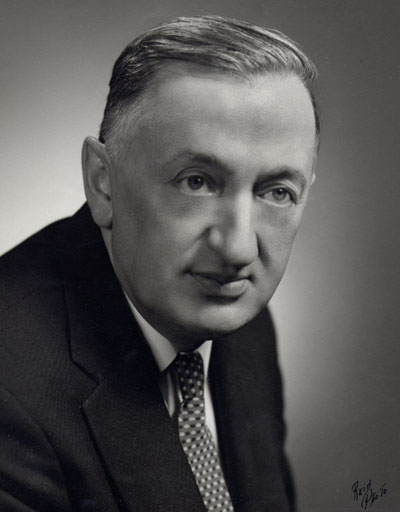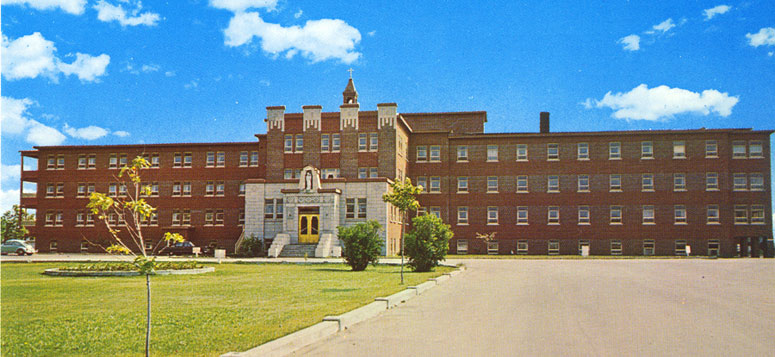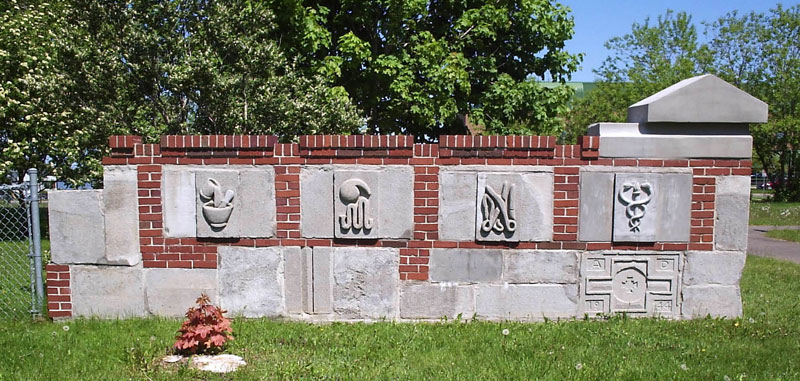From the start, the Lazaret or Hôtel-Dieu of Tracadie played an important role in the region by bringing relief and medical care, but also, tenderness and compassion to the lepers first, and then to the other sick people of the region.
Background History of the Lazaret
The origin of leprosy in Tracadie is rather obscure. However that may be, it is a fact that the first known victim of leprosy died at her home in Tracadie in 1828.
 In 1842, Father F.X. La France arrived as resident priest. He succeeded in convincing the Health Office that it was timely to construct a leprosy clinic in his parish. The wooden building, built in 1849, was surrounded by a high fence.
In 1842, Father F.X. La France arrived as resident priest. He succeeded in convincing the Health Office that it was timely to construct a leprosy clinic in his parish. The wooden building, built in 1849, was surrounded by a high fence.
Father Ferdinand Gauvreau took over from Father La France in 1852 and continued his work. He multiplied his efforts to convince civil authorities of the importance of the cause and alerted public opinion through newspaper articles about the need to improve conditions at the Lazaret. In 1860, Monsignor Rogers was appointed bishop of the new diocese of Chatham. In 1867, he authorized Father Gauvreau to request the services of the Religieuses Hospitalières de Saint-Joseph of l’Hôtel-Dieu de Montréal, who generously accepted to take on this difficult mission.
When the Mother Superior asked for volunteers for that foundation, all the nuns, without exception, submitted their candidacy. Six of them were chosen: Mère Marie Pagé, Sœur Eulalie Quesnel, Amanda Viger also known as Saint-Jean-de-Goto, Delphine Breau, Clémence Bonin and Philomène Fournier also known as Lumina.
The Arrival of the R.H.S.J in New Brunswick
 In 1868, the Hospitalières de Saint-Joseph became PIONEERS and INNOVATORS in hospital care.
In 1868, the Hospitalières de Saint-Joseph became PIONEERS and INNOVATORS in hospital care.
Upon their arrival in Tracadie, the Hospitalières organized a small clinic adjacent to the leprosy. Soon, numerous sick people from the region and elsewhere showed up. The Sisters treated all those who came, but due to lack of space, they could not accept those who were seriously sick. For that reason, in 1875, they started procedures for the construction of a general hospital but they would have to wait twenty years before the project was completed.
With the years, those wooden buildings would deteriorate and the premises were far from being adequate to lodge both the seriously sick and those who had just been infected with leprosy.
 It had become necessary to expand or still, to build stronger and bigger.
It had become necessary to expand or still, to build stronger and bigger.
In 1893, the Federal government allotted credits to build a stone lazaret that would be completed in 1896. The lepers who occupied the premises on April 8, 1896 thought they were “in paradise”, since the large sitting rooms, the well- lit rooms contrasted so much with those of the primitive lazaret.
It had become necessary to expand or still, to build stronger and bigger.
The General Hospital
 Sister Amanda Viger tried to find the necessary funds to add a new building that would accommodate a general hospital. Construction progressed slowly, at the speed of charity sales, bazaars and other expedients. Finally, on November 1st, 1898, six patients were admitted.
Sister Amanda Viger tried to find the necessary funds to add a new building that would accommodate a general hospital. Construction progressed slowly, at the speed of charity sales, bazaars and other expedients. Finally, on November 1st, 1898, six patients were admitted.
That hospital, with a capacity of 30 beds, received its charter from civil authorities in 1907. The dream had come true.
The following years saw an ever increasing number of patients. Dr Alfred.C. Smith, who was still taking care of lepers, also treated patients at the hospital, free of charge until his death in 1909. His successor at the Lazaret, Dr J. Antoine Langis followed his footsteps.
In 1920, Dr J.E. Paulin arrived in the community and he became the first resident doctor to treat patients exclusively at the general hospital.
 That same year, the Superior and supervisor of the then hospital, Sister Isabelle Sormany, had the hospital completely refurbished and encouraged the nuns to take nursing courses and to obtain the required diplomas. Several nuns became registered nurses, pharmacists, and dieticians, as well as laboratory and radiology technicians.
That same year, the Superior and supervisor of the then hospital, Sister Isabelle Sormany, had the hospital completely refurbished and encouraged the nuns to take nursing courses and to obtain the required diplomas. Several nuns became registered nurses, pharmacists, and dieticians, as well as laboratory and radiology technicians.
In 1921, Sister Turcotte was the first in Tracadie to receive a diploma in nursing from the Nursing School in Campbellton. She received a diploma in pharmacy in 1923. Others would soon follow.
The First Medical Office
A medical office was established in 1925 with the following doctors as members: Dr J.Ernest Paulin, Dr F.X. Comeau, Dr C.J. Veniot and Dr Edmond Haché.
In 1930, the Tracadie hospital received the approval of the American College of Surgeons, testifying that it filled all the requirements to be classified as a model hospital. In 1934, Dr J.E. Paulin left his duties at the hospital to become medical hygienist for the northern part of the province until 1949. Then, he returned to his general practice until his death in 1971.
The School of Nursing
In 1930, the Hôtel-Dieu de Tracadie was authorized by the New Brunswick Association of Nurses to open a school of nursing for the nuns.
Starting in 1947, the Association allowed the school to admit young women. Mildred Coughlan of Tracadie, having started her studies in Campbellton, joined the group in her second year. Thus, she became the first laic nurse to obtain a diploma in 1950, together with Sr Edwilda Mallet, Sr Dorina Frigault and Sr Ste-Rose de Lima (Albert). Between 1947 and 1963, the year that the school closed, 74 nurses received their diploma.
In 1951, a school of assistant nurses opened. Until its closure in 1973, 348 students, male and female, received their diploma.
The Arrival of a Surgeon
 In 1934, Dr Aldoria Robichaud arrived as surgeon at the hospital where he worked until his retirement in 1984. He was known for his untiring devotion to his patients and his important contribution to the Tracadie hospital.
In 1934, Dr Aldoria Robichaud arrived as surgeon at the hospital where he worked until his retirement in 1984. He was known for his untiring devotion to his patients and his important contribution to the Tracadie hospital.
On July 5, 1980, he was awarded the Order of Canada in recognition of his 50 years of services as a surgeon.
Fire Destroys the Hospital
An ordeal hit the community. In the afternoon of January 6, 1943, a fire destroyed all together the Lazaret, the hospital and the convent. All the patients were successfully evacuated and they were lodged in rooms at the Académie Sainte-Famille. Lepers were treated at the home of Dr W. T. Ryan, supervisor of the Lazaret. Thus, medical care was provided to the patients in the wake of reconstruction.
L’Hôtel-Dieu St-Joseph
 Reconstruction was put into action by the courageous hospitalières. Since the beds requirements for lepers had greatly diminished, the new 80-bed hospital occupied the greatest part of the building, while the Lazaret became a secondary facility, being located in an adjacent wing behind the building. The first patients were admitted in March 1946.
Reconstruction was put into action by the courageous hospitalières. Since the beds requirements for lepers had greatly diminished, the new 80-bed hospital occupied the greatest part of the building, while the Lazaret became a secondary facility, being located in an adjacent wing behind the building. The first patients were admitted in March 1946.
On July 1946, His Excellence Monsignor Ildebrando Antoniutti, apostolic delegate to Canada, solemnly blessed the new building. An enthusiastic crowd attended the ceremony.
From 1898 to 1991, 185,901 patients were treated at the Hôtel-Dieu in Tracadie, not counting births.
Government Involvement
In 1959, the provincial government put in place the hospital insurance and in 1971, Medicare. The financial responsibility for hospital was transferred to the provincial government with a Board of directors for each institution. In 1976, Mr. Bernard Aubé was appointed as chief executive officer for the hospital where several nuns still worked in the various departments.
 With the growing needs, the provincial government constructed a new hospital that opened in 1991. Shortly after, the Hôtel-Dieu St-Joseph building was demolished.
With the growing needs, the provincial government constructed a new hospital that opened in 1991. Shortly after, the Hôtel-Dieu St-Joseph building was demolished.
The evolution of hospital care continued with the regionalization of provincial health care services in 1992. Tracadie, Caraquet, Lamèque are now part of Chaleur Network (Bathurst) listed thereafter as Réseau Nor’Est Acadie-Bathurst and presently Regional Health Authority A. Proof reading here!!!
